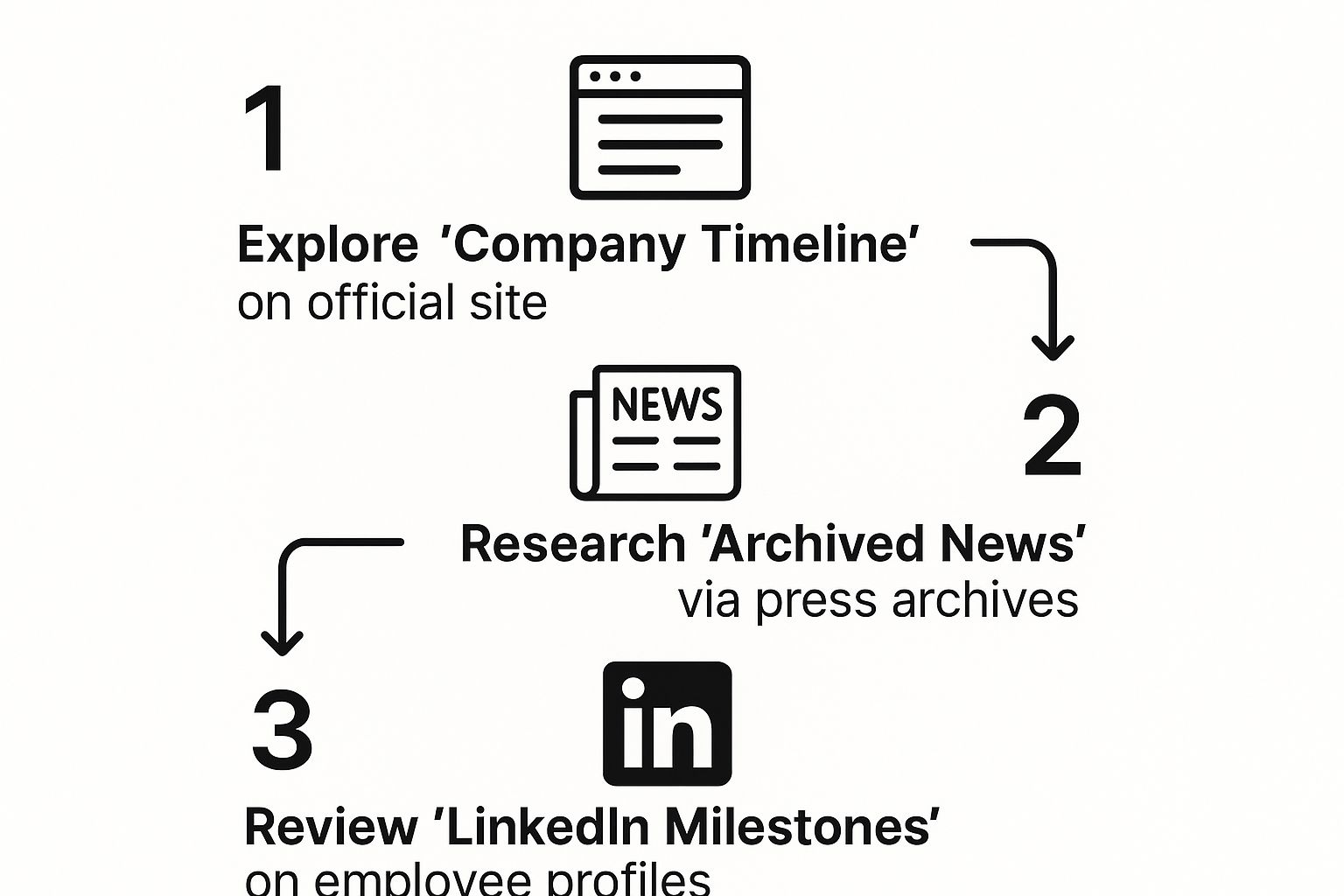How to Research a Company Before Interview: Expert Tips

Knowing how to research a company before an interview is about more than just a quick skim of their website. It’s a deep dive—a mission to understand their purpose, recent wins, and unique culture. This is what separates a good candidate from an unforgettable one and turns pre-interview jitters into solid confidence.
Why Company Research Is Your Secret Weapon
Let’s be real: walking into an interview cold is a recipe for disaster. Putting in the research time beforehand gives you a massive edge. It's shocking how many people skip this step, but it’s true. LinkedIn data reveals that a staggering 47% of candidates are rejected simply because they don't know enough about the company they want to join.

This preparation isn’t just about avoiding an early exit; it’s about elevating the entire conversation. When you genuinely understand the company's current challenges and latest successes, you can frame your skills as the exact solution they’ve been looking for.
Your Pre-Interview Research Checklist
Here's a quick look at the essential areas to cover in your research. This checklist provides a clear roadmap for the strategies we'll explore in detail.
| Research Area | What to Look For | Why It Matters |
|---|---|---|
| The Company Website | Mission, values, products, team bios | Shows you understand their core identity and purpose. |
| Financials & Funding | Revenue, funding rounds, investor reports | Proves you understand the business side and its growth trajectory. |
| Company Culture | Employee reviews, social media, mission statement | Helps you determine if you're a good fit for their environment. |
| Products & Services | Core offerings, target audience, unique features | Allows you to speak knowledgably about what they actually do. |
| News & Press | Recent announcements, industry articles, awards | Demonstrates you're up-to-date on their latest achievements. |
| Social Media Presence | Content, tone, engagement, key campaigns | Gives you a feel for their brand voice and market positioning. |
This table is your starting point. Now, let's look at how to use this information to make a real impact.
Go Beyond Basic Facts
Anyone can memorize a mission statement off the "About Us" page. What really stands out is understanding the why behind their operations. For instance, if you're targeting a fast-scaling startup, a detailed guide to vetting companies before an interview can offer invaluable insights into what to look for.
This deeper level of understanding empowers you to:
- Frame your answers to show how your background directly addresses their specific pain points.
- Ask smart questions that prove you’re thinking about their future, not just your own.
- Build a real connection with your interviewer by discussing topics that are actually on their radar.
The goal isn't just to collect facts; it's to build a narrative. You want to show the hiring manager that you aren't just looking for any job—you are specifically choosing their company for well-thought-out reasons.
At the end of the day, this homework shows you're invested, proactive, and serious. It’s a clear signal that you respect their time and are ready to contribute from day one. That upfront effort can be the single thing that sets you apart and helps you land the offer.
Decoding the Company's Digital Footprint
Your first stop in the research process should always be the company's own turf: its website. Think of it less as a brochure and more as the company's autobiography. It’s where they tell their own story, and it’s your job to read between the lines.
Start with the pages that are practically begging to be read. The 'About Us' and 'Careers' sections are your best friends here. They're designed to spell out the company's mission, vision, and the kind of people they want on their team. Getting a feel for this helps you frame your own experience in a way that shows you'll fit right in. You can find some great tips for aligning your story with the company's values on myinterviewpractice.com.
But don't just stop at the mission statement. Look for proof of their values in action.
- Press or News Section: What are they celebrating right now? A new product, a big-name partnership, or a community project can tell you a lot about their current priorities.
- Leadership or Team Bios: Get to know the key figures. A quick look at their backgrounds can offer a glimpse into the company's strategic thinking and the kind of leadership that thrives there.
- Investor Relations Page: You don't need to be a Wall Street analyst to get value here. These pages often have presentations that boil down complex business goals and challenges into easy-to-understand language.
Mine the Job Description for Clues
The job description is more than a checklist; it's a distress signal. It’s the company saying, "We have a problem, and we need someone to solve it." Your job is to position yourself as that someone.
Read between the lines of the "Responsibilities" and "Qualifications" sections. If you see phrases like "streamlining processes" or "driving user engagement" pop up multiple times, you've just uncovered a major pain point. Speaking directly to those needs in your interview is a game-changer.
This infographic lays out a straightforward way to dig into a company's past and present.

Following these breadcrumbs helps you piece together the company's journey—connecting its history to where it stands today. By the end, you'll have a rich, detailed picture that goes way beyond a quick Google search. This depth of understanding will shine through in your answers and the questions you ask, proving you aren’t just looking for any job—you're genuinely invested in this one.
Getting a Feel for Their Business Health and Market Position
To really get inside a company's head, you need to think like a strategist, not just a job applicant. This means looking past the cool products and digging into the company's actual business health and where it fits in the market. You don't need an MBA for this—you just need to know where to look.

If the company is publicly traded, their quarterly earnings reports are your best friend. Head over to the "Investor Relations" section of their website to find them. Don't get bogged down in the spreadsheets; you're looking for the story behind the numbers. I always listen to the earnings call recording or skim the transcript. Pay close attention to what the CEO and CFO are highlighting.
- Key Initiatives: What big projects are they fired up about?
- Revenue Drivers: Where is the money really coming from? Which products or services are carrying the team?
- Identified Challenges: What problems or obstacles are they admitting to?
This isn't just trivia. These points clue you in on their biggest priorities and hint at exactly where your role could add value right away.
Sizing Up the Competition
You can't truly understand a company in a vacuum. You have to know who they're up against. Who are their main rivals, and what makes this company think they can win? A simple Google search for "[Company Name] vs." usually gives you the main players.
Once you have a few names, start comparing. How do they talk about themselves? One company might be the low-cost leader, while another sells itself on being the premium, white-glove option. This is more than just marketing fluff; it’s the core of their entire strategy. Getting a handle on these details is a core part of fundamental analysis, which helps you assess a company's real value and potential.
When you know the competitive landscape, you can ask killer questions in the interview. Try something like: "I saw that Competitor X just rolled out a new feature. How is the team here thinking about maintaining our edge in that space?"
A question like that instantly shows you've done your homework. It proves you’re not just looking for a paycheck; you’re already thinking about how to help the business succeed. It shifts the entire dynamic from a simple Q&A to a collaborative, strategic conversation, making you look less like a candidate and more like a future colleague.
Getting a Feel for the Real Company Culture
Every company's website paints a rosy picture of its culture. It’s the polished, perfect version they want you to see. But to figure out what it’s actually like to work there day-in and day-out, you have to peek behind the marketing curtain.
The best way to do this is by digging into unfiltered employee feedback. Platforms like Glassdoor, Indeed, and even Reddit threads can be goldmines of information.
Don't get hung up on the overall star rating. A 4.2-star rating is just a number without context. Instead, start looking for patterns. Are different people in different departments all bringing up the same points, months or even years apart? That’s when you know you’re onto something real.
- Positive Signs: Keep an eye out for repeated praise for supportive managers, clear opportunities for growth, or a real commitment to work-life balance.
- Red Flags: Pay close attention to recurring complaints about burnout, a lack of communication from leadership, or a toxic "blame culture." One disgruntled ex-employee is just an anecdote, but ten people saying the same thing signals a pattern.
This kind of deep dive is more important than ever. In today's hiring environment, recruiters notice and appreciate candidates who've done their homework, as it shows you're serious about finding a place where you'll truly fit in. You can actually see this reflected in recent recruiting trends.
Get to Know Your Interviewers
Once you have the names of the people you’ll be meeting, it’s time to learn a little about them. This isn't about being creepy; it’s about finding ways to connect and understanding where they're coming from. Your first stop should be their LinkedIn profiles.
Your goal here is to find common ground and piece together their professional story. What you uncover can help you shape the conversation and ask much better, more specific questions.
A quick scan of your interviewer’s LinkedIn might show they used to work at a company you admire, or maybe they just shared an article on a topic you're really into. Bringing this up is a simple, authentic way to build a connection that a standard Q&A just can't match.
Here are a few key details to look for:
- Their Time at the Company: How long have they been there? Someone who joined six months ago will have a vastly different perspective than a 10-year veteran.
- Their Career Trajectory: Did they climb the ladder internally, or were they brought in from the outside? This can tell you a lot about their experience and what the company looks for in its people.
- Their Recent Activity: Have they posted, shared, or commented on anything lately? This is a great window into their current professional interests and what’s on their mind at work.
Doing this bit of personal research transforms the interview from an interrogation into a genuine conversation between two professionals. It shows you’re not just prepared—you’re genuinely interested.
Weaving Your Research into the Conversation
All that digging you did? It's gold, but only if you know how to spend it. Simply knowing facts about a company isn't the point. The real magic happens when you weave those nuggets of information into your interview conversation, turning a standard Q&A into a compelling story about why you belong there.
This isn't about reciting the company's Wikipedia page. It's about connecting what you've learned to what you can do for them. This shifts the dynamic, showing you’re not just a candidate looking for a job, but a strategic partner ready to contribute.
Answering “Why Do You Want to Work Here?”
This question is a golden opportunity, so don't waste it with a generic answer. It’s your chance to show them you’ve done more than just read the job description. A weak answer focuses only on what you want. A powerful one connects your ambition directly to the company's journey.
- Before Research: "I’m looking for a new challenge in a growing company, and this role seems like a great fit for my skills." (This could be said about hundreds of companies.)
- After Research: "I was really impressed when I read about your recent expansion into the APAC market. With my background in international logistics, I got excited thinking about how I could help tackle the specific supply chain challenges that come with that kind of rapid growth."
See the difference? The second answer proves you're not just looking for any job. You’re interested in this company and its current, specific goals.
Your best answers will always build a bridge between a specific company detail—a product launch, a core value, a recent achievement—and a personal skill or passion you bring to the table. This shows you're already thinking about how you'll make an impact.
Asking Questions That Make an Impression
The questions you ask at the end of an interview are just as important as the answers you give. This is where your research truly shines. Forgettable candidates ask generic questions. Memorable ones ask questions that prove they’re already thinking like part of the team.
A great place to get inspiration is by looking at employee sentiment on platforms like Glassdoor.
If you spot a recurring theme in the reviews—good or bad—you have the foundation for a thoughtful, specific question. Let's say you notice a lot of positive comments about mentorship.
Instead of asking, "What's the culture like?" you can ask something much more insightful:
"I noticed on Glassdoor that many employees, both current and former, praise the company's mentorship program. Could you tell me a bit more about how that program helps new hires get up to speed in their first six months, especially within this department?"
This kind of question does two things: it shows you took the initiative to dig deeper, and it signals a genuine interest in your own long-term development at the company. For more ideas on building a smart interview strategy, check out the Parakeet AI blog.
Common Questions About Company Research

Even with a solid game plan, you're bound to hit a few snags while digging into a potential employer. How deep do you really need to go? And what happens when you're looking at a private company that keeps its financial cards close to its chest? Let's walk through a couple of the most common hurdles you'll likely encounter.
How Much Time Should I Actually Spend on This?
This is probably the number one question I get. While there’s no magic formula, my go-to recommendation is to block out at least two to three hours for some solid, focused research.
Here’s a practical way to break down that time:
- Hour 1: Cover the Essentials. Start with the company website. Your goal here is to get a firm handle on their mission, products, and services. Who are they and what do they do?
- Hours 2-3: Go a Level Deeper. This is where you branch out. Hunt down recent news articles, see what current and former employees are saying on Glassdoor, and absolutely look up your interviewers on LinkedIn.
Remember, the point isn't to become a walking encyclopedia of company trivia. It's about building a strong enough knowledge base to hold an intelligent, confident conversation. You might need more time for a senior role at a huge corporation and a bit less for an entry-level spot at a small startup. Adjust accordingly.
What If the Company Is Private?
Researching a private company can feel like you've hit a wall, especially since they don't have to disclose their financials like public companies do. But don't worry, there's still plenty of information out there if you know where to look.
You just have to get a little more creative. Instead of searching for SEC filings, turn to platforms like Crunchbase or PitchBook. These are goldmines for information on funding rounds, investors, and company growth.
Also, don't forget about trade publications and local business journals. They often cover major milestones, new product rollouts, or executive hires at private companies in their area. By piecing together these different sources, you can build a surprisingly detailed picture of the company's health and direction.
Supercharge your interview preparation with ParakeetAI. Get real-time, intelligent answers to tough questions, integrate with coding platforms, and walk into any interview with the confidence of an expert. Try ParakeetAI today and land your dream job




